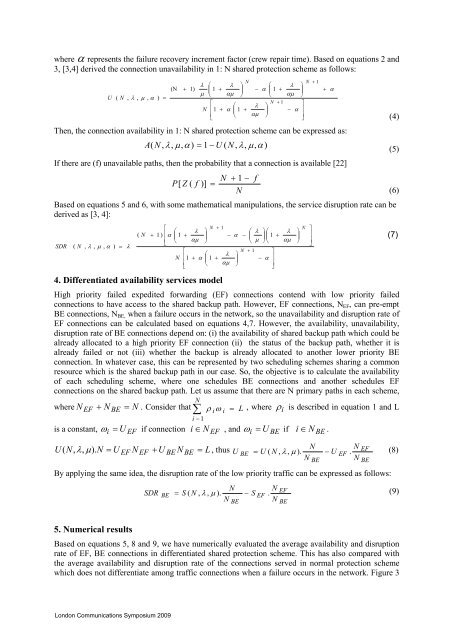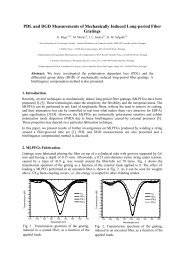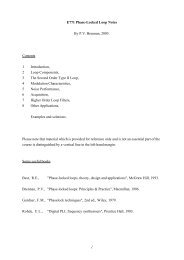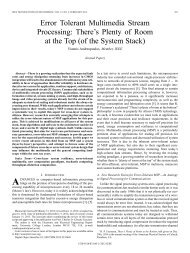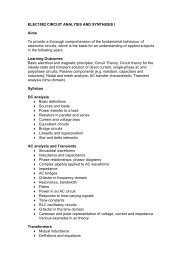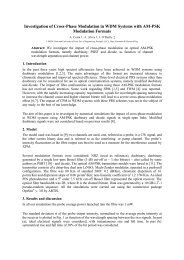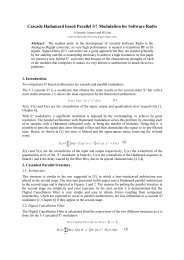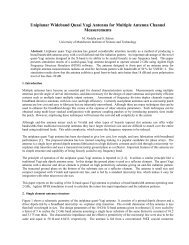Modelling Differentiated Availability Services in IP-Over-WDM ...
Modelling Differentiated Availability Services in IP-Over-WDM ...
Modelling Differentiated Availability Services in IP-Over-WDM ...
You also want an ePaper? Increase the reach of your titles
YUMPU automatically turns print PDFs into web optimized ePapers that Google loves.
where α represents the failure recovery <strong>in</strong>crement factor (crew repair time). Based on equations 2 and3, [3,4] derived the connection unavailability <strong>in</strong> 1: N shared protection scheme as follows:U ( N , λ , µ , α ) =(N+ 1)Nλ ⎛ λ ⎞⎜ 1 + ⎟µ ⎝ αµ ⎠⎡⎛N ⎢1+ α ⎜ 1 +⎢⎣⎝N + 1⎛ λ ⎞− α ⎜ 1 + ⎟ + α⎝ αµ ⎠N + 1λ ⎞⎤⎟ − α ⎥αµ ⎠⎥⎦Then, the connection availability <strong>in</strong> 1: N shared protection scheme can be expressed as:A( N , λ,µ , α ) = 1 − U ( N , λ,µ , α )If there are (f) unavailable paths, then the probability that a connection is available [22]P[Z ( f )] =N + 1 −NBased on equations 5 and 6, with some mathematical manipulations, the service disruption rate can bederived as [3, 4]:SDR( N , λ , µ , α )=λ( N⎡N + 1⎛ λ ⎞⎛+ 1 ) ⎢ α ⎜ 1 + ⎟ − α − ⎜⎢⎣⎝ αµ ⎠⎝⎡N + 1⎛ λ ⎞N ⎢1+ α ⎜ 1 + ⎟⎢⎣⎝ αµ ⎠4. <strong>Differentiated</strong> availability services modelfλµ⎞ ⎛⎟ ⎜ 1 +⎠ ⎝⎤− α ⎥⎥⎦High priority failed expedited forward<strong>in</strong>g (EF) connections contend with low priority failedconnections to have access to the shared backup path. However, EF connections, N EF , can pre-emptBE connections, N BE, when a failure occurs <strong>in</strong> the network, so the unavailability and disruption rate ofEF connections can be calculated based on equations 4,7. However, the availability, unavailability,disruption rate of BE connections depend on: (i) the availability of shared backup path which could bealready allocated to a high priority EF connection (ii) the status of the backup path, whether it isalready failed or not (iii) whether the backup is already allocated to another lower priority BEconnection. In whatever case, this can be represented by two schedul<strong>in</strong>g schemes shar<strong>in</strong>g a commonresource which is the shared backup path <strong>in</strong> our case. So, the objective is to calculate the availabilityof each schedul<strong>in</strong>g scheme, where one schedules BE connections and another schedules EFconnections on the shared backup path. Let us assume that there are N primary paths <strong>in</strong> each scheme,where N EF + N BE = N . Consider that∑Ni − 1λαµ⎞⎟⎠N ⎤⎥⎥⎦(4)(5)(6)(7)ρ iωi = L , where ρ i is described <strong>in</strong> equation 1 and Lis a constant, ω i = U EF if connection i ∈ N EF , and ω i = U BE if i ∈ N BE .U ( N,λ , µ ). N = U EF N EF + U BE N BE =L , thusN NUEFBE = U ( N , λ , µ ). − U EF . (8)NNBy apply<strong>in</strong>g the same idea, the disruption rate of the low priority traffic can be expressed as follows:N NSDREFBE = S ( N , , µ ). − S EF .N BE N BEλ (9)BEBE5. Numerical resultsBased on equations 5, 8 and 9, we have numerically evaluated the average availability and disruptionrate of EF, BE connections <strong>in</strong> differentiated shared protection scheme. This has also compared withthe average availability and disruption rate of the connections served <strong>in</strong> normal protection schemewhich does not differentiate among traffic connections when a failure occurs <strong>in</strong> the network. Figure 3London Communications Symposium 2009


